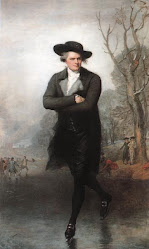
I always look forward, somehow, to doing my Random Monthly Pick, with some minor fear and trepidation (in addition to the anticipation!) ... What if the person is entirely boring? What if he or she is a null, with a life from which no narrative unfolds! But, I think, somehow every person in some way, shape or form, can tell a story. Jewish merchant of New York, Solomon Moses, in his own special way, comes to us with an INTERESTING TWIST !
I read the entry from Park, and thought: oh oh.
from Lawrence Park;
Solomon Moses 1774-1857
A merchant in New York. In 1806 he married Rachel, daughter of Michael and Miriam (Simon) Gratz of Philadelphia.
Lawrence Park also indicates there was a bridal portrait of Rachel, wife of Solomon and says: “She was noted for her blond beauty. ...She brought up a large family of children, but her life, compared with that of her better-known sister Rebecca (1781-1869), was short and uneventful.” Then there is a brief description of the painting (shown above), and no more detail regarding the individual or portrait.
But...., I wondered....
WHO was Rebecca Gratz?
and hereupon I came across one of those specialized, wonderful blogs that have sprung up like wild flowers in the internet landscape....
"Rebecca Gratz (1781-1869), a Philadelphia philanthropist, founded the first Hebrew Sunday School in America and participated as a founding member in several other nonsectarian and Jewish charitable organizations which were among the first to be organized and run by women. Besides her good works, she is remembered today for her beauty, her thwarted love affair with a non-Jew and the persistent story that she was the inspiration for the character of Rebecca in Scott's novel Ivanhoe."
The following is an excerpt from the Rebecca Gratz blog

Sleigh Bells Ring
An unscientific survey of the weather information in Rebecca Gratz's letters shows that Philadelphia winters were as variable in the nineteenth century as they have been in more recent years. One December she is gathering roses in her garden; in another she is housebound by rain and ice. But when snow came, and it seems to have come more frequently than in the 21st century, people of Rebecca's time had one thing that added greatly to the season's charm: travel by sleigh.
On a November evening in 1800, after a snowstorm, Rebecca's friend Maria Fenno in New York wrote that there was "no other noise but the jingling of sleighs" in the street outside her house.
Lovely as the sleigh bells were, Maria's words point up their reason for being: sleighs moved silently, the horses' hoofs muffled by the snow -- the bells alerted the unwary to their approach.
In January 1805 Eliza Fenno, Maria's little sister, recorded another evening made magical by sleigh bells. A friend of Eliza's had planned to give a dance at her house, but on the day of the event there was a heavy snowstorm, and by 8 p.m. no one had come. "We were in despair when the sound of sleigh bells coming down the lane made our hearts leap...." The sleigh brought "a cargo of beaux," and more sleighs soon followed. It was "a most delightful dance," Eliza wrote Rebecca, and the party did not break up until 3 a.m.
Another pleasure the sleigh afforded was to old people whose joints could no longer take the bouncing of carriages and wagons on the truly terrible roads which existed in most parts of the country in the early nineteenth century. A sleigh, however, could give them a smooth ride to those they could no longer visit at most times of the year -- and then whisk them home again before the snow melted.
Finally, there were sleighing parties similar to the one pictured in a detail from the painting above by John Lewis Krimmel. Here a sleigh full of merrymakers is probably making a tour of inns in the area where they can stop, warm up, drink, then go on to the next hostelry. As they are pictured here, the partiers are feeling no pain, probably noisy and a menace to other traffic. Sleighs, it seems, for all their charm, could be used recklessly.
"I discovered Rebecca Gratz when I became a docent at the Rosenbach Museum & Library which has a lovely portrait of her by Thomas Sully. To learn more, I began to read the hundreds of Gratz family letters which survive in libraries around the country and found wonderful stories about Rebecca as well as information about customs, events and technological changes of her time."

















